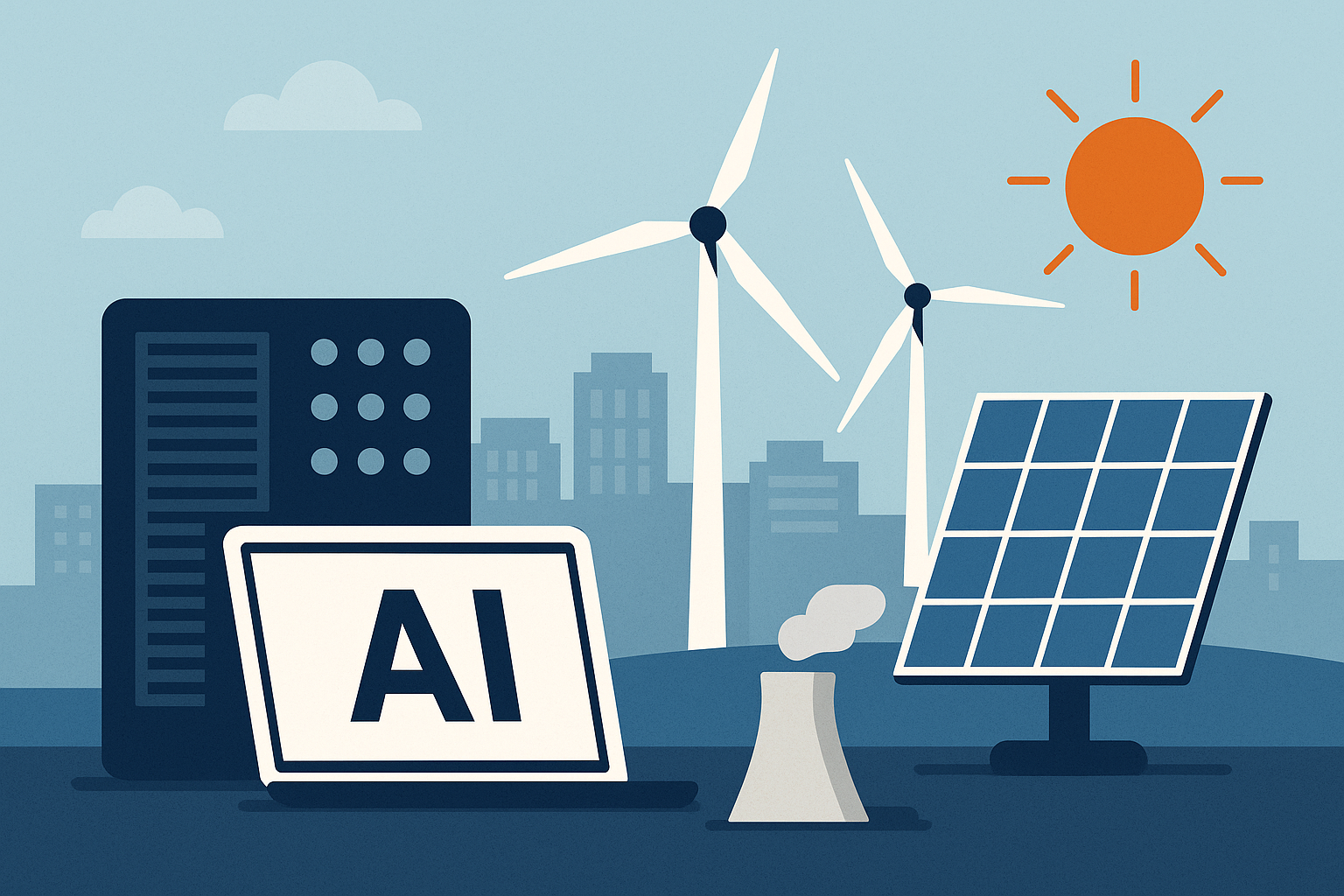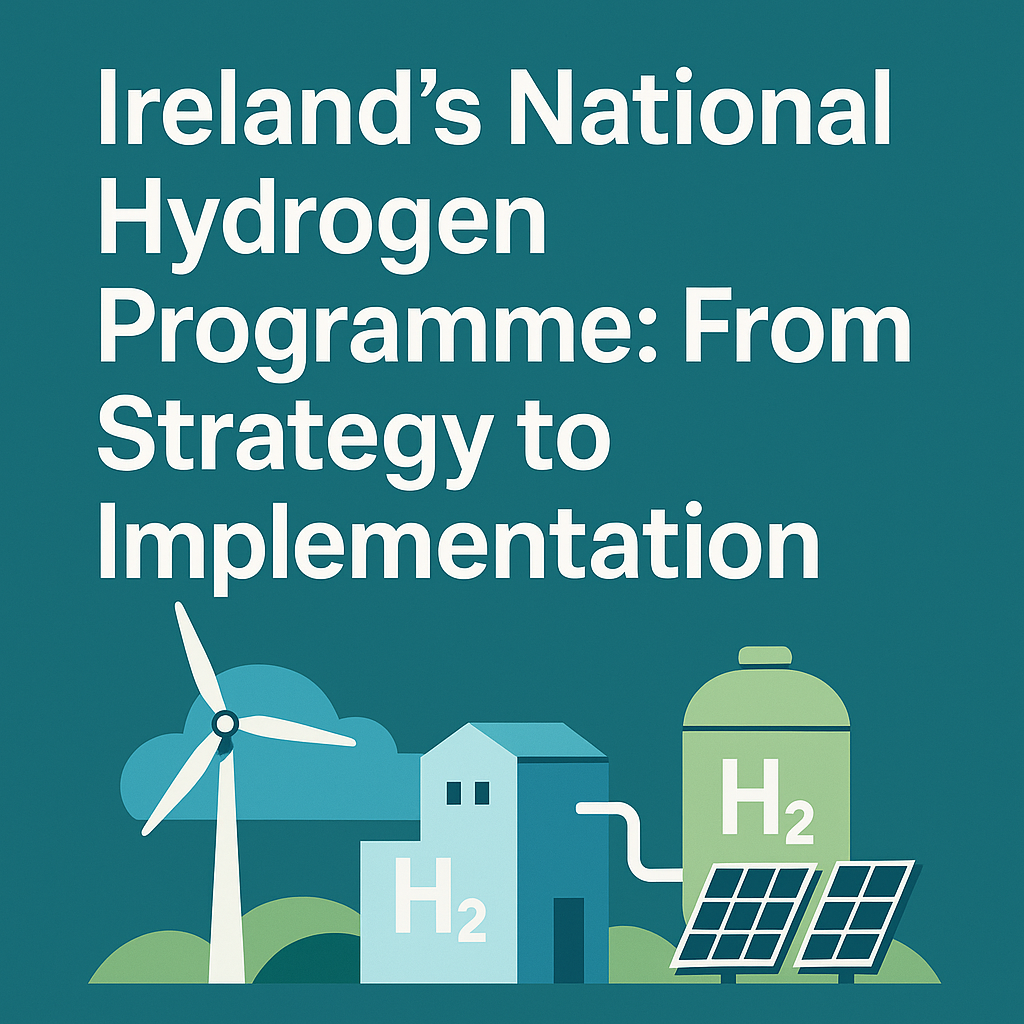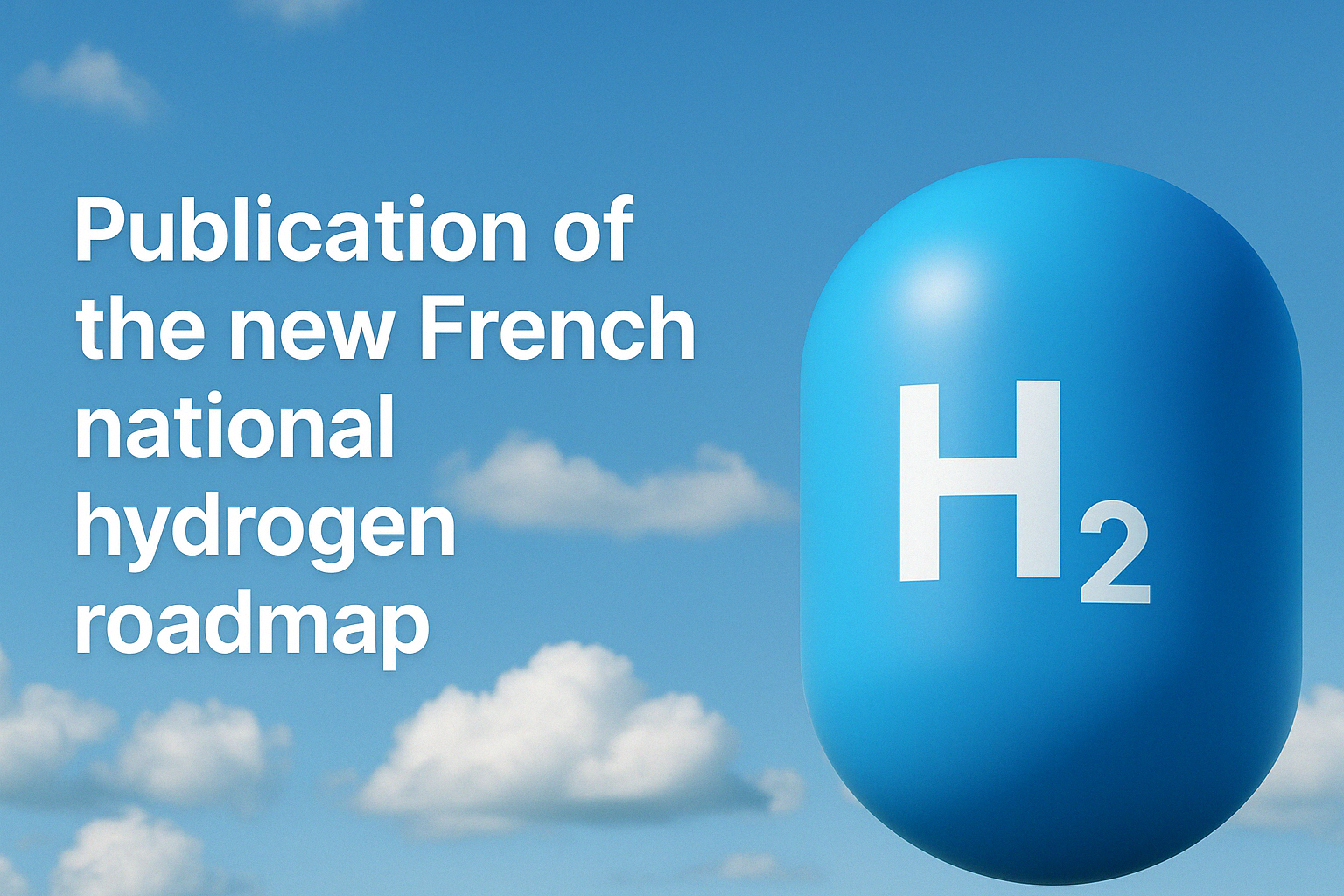AI and Energy: A Franco-Irish Blueprint for a Sustainable Digital Future

Artificial Intelligence is reshaping economies but also driving unprecedented energy demand. France, with its nuclear strength, and Ireland, as a data hub betting on offshore wind, illustrate Europe’s paradox—and its chance to build a sustainable AI–energy blueprint.
Introduction: The Energy–AI Paradox
Artificial Intelligence (AI) is widely perceived as the crown jewel of the digital age. Its capacity to learn, adapt, and transform is already reshaping industries from healthcare to finance, from logistics to education. Yet beneath the dazzling surface lies a fundamental paradox: AI runs on energy. The servers, chips, and cooling systems that sustain AI consume vast amounts of electricity. Training a single large model can use as much power as hundreds of households in a year. Inference at scale—everyday use by millions of people—represents an even more sustained load.
The International Energy Agency (IEA), in its landmark Energy and AI report, provides a sobering projection: global electricity demand from data centres, AI, and cryptocurrency mining could double by 2030, reaching almost 1,000 terawatt-hours.1 To put this in perspective, this is roughly equivalent to the annual consumption of an industrialised nation like Japan. One hyperscale AI data centre can already consume the equivalent of 100,000 households, and future sites could reach the load of two million households.
This is the paradox of our century: AI both threatens to overwhelm energy systems and offers tools to optimise those very systems. It is simultaneously a source of demand and a potential solution to accelerate the green transition. The question is whether this tension becomes a vicious circle of runaway consumption—or a virtuous cycle of efficiency, innovation, and sustainability.
France and Ireland, though very different in size, approach, and resources, offer a unique vantage point on this debate. France is positioning itself as a host for data centres thanks to its nuclear fleet and industrial ecosystem, while Ireland has already become a dense hub of data infrastructure, facing the consequences but also pioneering new solutions, especially offshore wind. Together, the two countries provide a European laboratory for reconciling AI and energy.
The Global Challenge: AI’s Energy Footprint
AI’s energy demand is not hypothetical—it is already here, and growing fast.
First, trainng frontier models has escalated exponentially. GPT-3 in 2020 required hundreds of petaflop/s-days of compute; GPT-4 and successors push far beyond that. Each iteration increases computational intensity by an order of magnitude. Training these models often requires months of GPU cluster usage, with dedicated energy bills to match.
Second, inference at scale has become the dominant factor. Millions of queries per day on large language models mean that servers must remain active and cooled constantly. Even if each query seems light, the aggregate volume turns into a massive sustained load.
Third, data centre clustering amplifies these challenges. The IEA stresses that energy demand is not evenly distributed: it is concentrated in specific geographies where hyperscale facilities cluster. Dublin, Frankfurt, Amsterdam, Paris, and certain US states are prime examples. In these regions, a single new data centre connection can require as much capacity as an entire mid-sized town.
If nothing changes, the collision course is clear: energy systems designed for predictable, steady demand will be strained by the volatile and rising load of AI.
France: Nuclear Advantage and Strategic Hosting
France enters the debate from a position of relative strength in terms of energy mix. With 56–57 nuclear reactors across 18 sites, France derives around 70% of its electricity from nuclear, one of the lowest-carbon baselines in Europe. This energy model offers something rare: stable, dispatchable, low-carbon electricity—exactly what hyperscale data centres crave.
In recent years, French actors have started to translate this structural advantage into a deliberate strategy to host digital infrastructure.
Nuclear contracts for data centres
The most notable example is Data4, a major European data centre operator headquartered in France. In 2025, Data4 signed a 12-year agreement with EDF to secure 40 MW of nuclear-sourced electricity, equivalent to around 230 GWh per year, dedicated to its Paris-region sites from 2026 onwards. This contract bypasses volatile wholesale markets, tying pricing to nuclear performance rather than fluctuating fossil markets. For Data4, it means predictable costs and a decarbonisation narrative. For EDF, it demonstrates nuclear’s role in the digital economy.
EDF is also offering turnkey sites for data centre development directly adjacent to nuclear plants, providing immediate high-voltage connections. This reduces infrastructure costs and ensures that data centres are directly fed with nuclear electricity.
France is also attracting interest in gigawatt-scale AI campuses. EDF has been in talks to power three separate 1 GW data centres in France, signalling a potential new wave of hosting capacity. To contextualise, one such facility could rival the total data centre capacity of an entire mid-sized European country.
Finally, innovation is underway: Data4 has entered into collaboration with Westinghouse to explore the use of Small Modular Reactors (SMRs), such as the AP300, to directly power data campuses. This idea—placing modular nuclear units next to hyperscale AI facilities—could redefine the infrastructure model for the next decade.
Strategic positioning
This trajectory gives France several advantages:
- Low-carbon branding: hosting AI workloads on nuclear electricity supports Europe’s climate goals.
- Energy sovereignty: nuclear reduces exposure to global gas price volatility.
- Investment attraction: AI companies seeking low-carbon hosting in Europe may find France uniquely positioned.
- Industrial ecosystem: French firms like Schneider Electric (efficiency systems), OVHcloud (European cloud), and EDF (nuclear provider) form a comprehensive supply chain.
In short, France is moving from being primarily a regulator and policymaker to a strategic host of infrastructure—turning its energy model into a competitive advantage in the AI era.
Ireland: Hub Under Strain, Offshore Wind Opportunity
Ireland, by contrast, has already become a frontline hub for data centres. Over the past two decades, Dublin has attracted massive investments from Amazon Web Services, Microsoft, Google, Meta, and others. Today, the Dublin metro area is one of the densest concentrations of hyperscale data centres in the world.
Energy stress and public perception
This success comes with costs. By some estimates, data centres already account for 18–21% of Ireland’s total electricity consumption. In certain years, their consumption has overtaken that of all urban households combined, a symbolic tipping point in the public debate. The stress on EirGrid, the national transmission operator, has led to connection moratoria in the Dublin area: new data centre connections are heavily restricted until at least 2028.
Public perception has also shifted. While the tech sector provides jobs and tax revenue, many citizens question why households are asked to conserve while international firms run energy-hungry facilities. Politically, this tension has become acute.
The offshore wind frontier
Yet Ireland also holds a trump card: its offshore wind potential. With one of Europe’s best wind resources, Ireland has set an ambition of 5 GW of offshore wind by 2030. Progress has been slow—permitting, investment, and planning bottlenecks abound—but recent reforms are accelerating momentum. In September 2025, the government announced the creation of an Offshore Wind Clearing House to streamline approvals and financing. EirGrid has committed over €1 billion to offshore grid infrastructure upgrades. The South East region is positioning itself as the national hub, with €1 billion in port and infrastructure investments planned to service offshore projects.
Crucially, the data centre sector could play a catalytic role. Operators are natural buyers of long-term renewable Power Purchase Agreements (PPAs). Their demand profile—steady, creditworthy, long-term—matches perfectly with the financing needs of offshore developers. Industry group IBEC has explicitly noted that data centres are “key to the delivery of Irish offshore wind”.
Towards symbiosis
If managed wisely, Ireland could turn its paradox into an asset. Data centres could become flexible loads, shifting consumption when renewables peak, while simultaneously anchoring offshore wind projects through PPAs. Ireland would then move from energy hostage to energy innovator—a living laboratory for integrating digital and renewable revolutions.
AI as a solution for energy optimisation
The dual identity of AI—as both energy consumer and potential optimiser—requires a sober examination of its applications in the energy sector. Beyond the general narrative, multiple institutional-level strategies already show how AI can become a structural ally to energy systems.
AI is increasingly deployed in smart grid operations. Transmission system operators such as RTE in France and National Grid in the UK use AI-enhanced forecasting models to balance supply and demand, anticipating renewable fluctuations with greater accuracy than classical methods. By predicting output from solar farms or offshore wind turbines hours or even days ahead, AI reduces the need for fossil-based backup capacity. This is particularly relevant for Ireland, where wind generation can swing dramatically within a single day.
Demand response systems are another key area. Instead of passively consuming, large users such as data centres can become active participants in grid stability. Through AI-driven orchestration, loads can be shifted to periods of high renewable availability. In practice, this means a data centre in Dublin could ramp down during an evening peak, or accelerate batch processing when offshore wind is abundant. France has experimented with similar mechanisms through Voltalis, a demand response aggregator that connects thousands of households, and the same principles can be applied at hyperscale for Irish facilities.
In the domain of cooling optimisation, AI has already delivered results. Google’s DeepMind demonstrated that machine learning could reduce cooling energy consumption in its data centres by up to 40%, saving both costs and emissions. These solutions can be replicated in Ireland’s hyperscale clusters, where cooling accounts for a large share of consumption, especially given the island’s temperate but humid climate.
Beyond operations, AI contributes to predictive maintenance of turbines, transmission lines, and reactors. By anticipating failures before they occur, operators can extend asset lifespans and reduce unplanned downtime. This not only saves money but avoids inefficient backup generation.
Finally, AI accelerates materials discovery for next-generation energy technologies. From new battery chemistries to hydrogen catalysts, machine learning can shorten R&D cycles that would otherwise take years of trial and error.
Taken together, these applications illustrate a broader truth: AI can be reframed not as a burden on energy systems, but as an embedded tool for their optimisation. The challenge for policymakers in France and Ireland is to scale these solutions from pilots to systemic deployment, embedding AI into the governance of grids and generation assets.
Frugal AI: Intelligence per Watt
While optimisation on the supply side is essential, an equally critical question is how to reduce demand at the source. This is where Frugal AI comes in—a paradigm that aims to deliver maximum intelligence with minimum resources.
Frugal AI encompasses a suite of techniques:
- Model compression, pruning, and quantisation reduce the number of parameters or the bit-depth of computations. Research has shown that these methods can cut inference costs significantly—sometimes by an order of magnitude in specific workloads—without major losses in accuracy.
- Efficient architectures are being developed to replace general-purpose GPUs with dedicated accelerators. ARM-based processors, ASICs, and neuromorphic chips exemplify a trend toward specialised hardware that consumes far less power for equivalent tasks.
- Edge AI moves computation closer to the data source. Instead of sending every data point from a smart meter or industrial sensor to a hyperscale centre, lightweight algorithms process them locally, reducing network traffic and central compute loads.
- TinyML pushes this to the extreme, enabling neural networks to run on microcontrollers consuming only milliwatts. Startups such as GreenWaves Technologies in France are pioneering this field, while in Ireland, design centres linked to ARM and Intel (Movidius) provide fertile ground for embedding low-power intelligence.
The strategic dimension of Frugal AI is profound. In a world where electricity supply is constrained, efficiency becomes a form of sovereignty. Countries that master frugal techniques can host more AI capability per unit of power, maximising both competitiveness and sustainability. It is not simply an engineering issue; it is a policy lever.
Europe is beginning to recognise this. Proposals to integrate energy-efficiency metrics into the AI Act have emerged in discussions, though not yet formalised. France, with its research base (Inria, CEA) and startups in embedded intelligence, is well placed to shape such standards. Ireland, as a host of dense infrastructure, could be the proving ground for mandatory deployment of frugal architectures in hyperscale centres.
The narrative thus shifts: the question is not how much energy AI consumes, but how much intelligence societies can afford per watt of electricity. Frugal AI turns efficiency into a measurable metric of progress, and a basis for regulation and industrial policy.
Franco-Irish complementarity
Placed side by side, France and Ireland illustrate complementary strengths in addressing the AI–energy nexus.
France contributes stable, low-carbon baseload from nuclear, a mature industrial ecosystem in energy and digital infrastructure, and political leadership in European regulation. Ireland brings a dense concentration of data centres, a real-world laboratory for stress-testing solutions, and some of the richest offshore wind resources in Europe.
At the institutional level, this complementarity suggests several avenues:
- Joint taskforces under Horizon Europe could align French R&D capacity with Irish deployment. Calls under Cluster 5 (Climate, Energy and Mobility) or the European Innovation Ecosystem (EIE) pillar could fund Franco-Irish demonstrators.
- MoUs between energy operators—for example, EDF and EirGrid—could establish frameworks for flexible nuclear-offshore synergies. Nuclear baseload from France could complement Irish wind variability, within the integrated European grid.
- Standards-setting initiatives could be co-led, with France contributing research expertise on Frugal AI and Ireland offering practical deployment feedback. Together, they could shape European norms on energy-efficient AI.
- Industrial cooperation could be deepened, linking French suppliers like Schneider Electric and OVHcloud with Irish-hosted hyperscale operators to implement efficiency solutions.
The upcoming Celtic Interconnector provides this partnership with a concrete backbone: a 700 MW subsea cable between Ireland and France, co-financed by the European Union under the Connecting Europe Facility. Initially planned for 2026 and now expected in 2028, it is not only a bilateral project but also a strategic European infrastructure. By enabling renewable exports from Ireland and secure low-carbon imports from France, it embeds the Franco-Irish alliance at the heart of Europe’s energy sovereignty agenda—bridging digital innovation, the green transition, and continental resilience.
From Paradox to Blueprint
The AI–energy nexus defines one of the greatest challenges of our time. AI threatens to consume vast amounts of electricity, yet it can also enable the energy transition. France and Ireland, though very different, embody this paradox. France offers nuclear stability and industrial ecosystems to host AI sustainably. Ireland illustrates both the risks and opportunities of dense digital clustering, with offshore wind as a potential saviour.
The missing link is Frugal AI—ensuring that intelligence grows not only in scale, but in efficiency. The future question is not how much energy AI consumes, but how much intelligence per watt societies can afford.
If France and Ireland act together—leveraging nuclear, offshore wind, digital expertise, and frugal innovation—they can transform a looming crisis into a blueprint for Europe and the world. The next decade will determine whether AI becomes a burden on the energy transition, or its most powerful ally.


